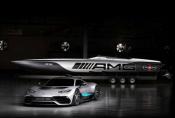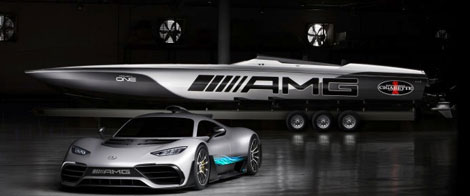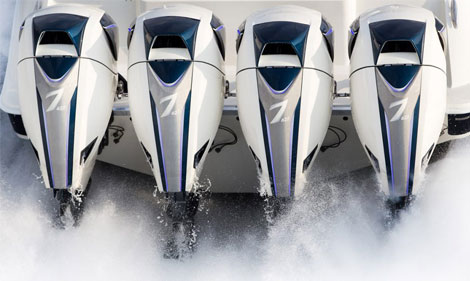Fast Boats Go Even Faster in Miami

19.02.2018

Cigarette Racing 515 Project ONE - Mercedes AMG
US fast boat manufacturers have raised the power and performance bar even higher yet again in 2018 – but it is clearly getting harder!
Wealthy powerboat buyers are natural first adopters with a deep rooted need for speed. Every February in Miami the Progressive International Boat Show hosts a number of product launches that ultimately affect the global marine industry, including professional operators.
Southern Florida is by far the largest market in the world for high performance power boats. It may take a few years, but eventually what happens on the waters around Miami impacts on the professional and commercial fast boat sectors.
Some of the largest naval and marine organisations are increasingly trying to buy Commercial Off The Shelf (COTS) products to fit out their vessels. For engines, propulsion systems, electronics and navigation systems COTS is the only way to keep up with technology and ensure ongoing spares support. Every February in Miami the cutting edge technology is launched to a very discerning group of boat users.
Only a few government organisations can afford to specify a hull design and size specifically to their needs. After 9-11 many of the US ‘go fast’ leisure boat manufacturers saw the largest boat procurements ever by coast guard, customs, borders and homeland security agencies as an opportunity to diversify. This was accelerated by the global recession in 2009, as their bright coloured hulls had very few customers the fast boat builders tried offering them in grey and blue for police and security roles. This was not as easy as it looked as, along with ‘top speed’ requirements, these milpro tenders specify rigorous testing in extreme conditions and long warranties to provide through life support. Most agencies now want to buy proven boat designs from specialist OEM builders that can deliver hulls and fittings that are able to withstand daily use in the military and professional maritime workplace.
In the 1980s, powerboats became associated with illicit cargoes of contraband. Scenes from Miami Vice of Crockett and Tubbs chasing bad guys across Biscayne Bay and around the waterways may be in the past, but a vast number of very capable offshore powerboats head out to sea every day and this is long coastline with numerous harbours and beaches. With the Caribbean and Bahamas close by, professional law enforcement agencies still want to know how fast and how far the boats they may be trying to intercept can go.
Only a few years ago virtually all offshore power boats were either long race boats with stand up bolsters and high sides to keep the occupants in the boat, or sport fishing designs. The classic sport fisherman had a cabin forward and a flybridge with upper driving position. Engines were typically gasoline (petrol) inboards, the go fast designs had surface piercing props and the slower sports fishermen used shafts running conventional propellers. Fuel economy was rarely mentioned and how much fuel burned in a day at sea was usually ignored.
The high-performance powerboat world is known for developing extreme engineering solutions to keep genuine race boats running hard and fast in the rough waters of the Gulf Stream that runs between the Bahamas and the east coast of Florida. V shaped hulls were modified with stepped bottoms to reduce drag and increase top speeds for monohulls to well over 100mph. In recent years the most obvious cosmetic change to go fast monohulls has been cut down sides, low decks, no cabin and sit down seating. Reduced weight and less windage has added to top speeds. The big racing catamarans changed the game dramatically, using a combination of hydrodynamics and aerodynamics to literally skim the water with speeds up to 200mph.
Coming out of the last global recession, three noticeable changes have transformed the fast boat ranges on show in Miami. Firstly, high-tech materials and composite construction are being utilized to make boats lighter and stiffer. Secondly, most major custom and semi-custom high-performance boat builders offer centre console designs across the size range. Centre console boats maintain a reasonable level of go-fast performance with the walk around decks offering increased versatility for fast cruising or they can be rigged for offshore fishing. Thirdly, power and propulsion has moved from twin inboard engines being the norm to multiple outboard engines layouts, particularly on the centre console designs. This coincided with outboard manufacturers delivering their top of the range units with significantly more horsepower.
The US economy has had a good year and the 2017/2018 boat show season has been booming. Numerous builders reported record sales at the Fort Lauderdale International Boat Show in November. There are plenty of boat and engine manufacturers challenging to be biggest and fastest, but two companies stand out as iconic brands and major game changers – Cigarette Racing boats and Seven Marine engines. Both are setting the bar very high with their latest flagship offerings.
Cigarette Racing 515 Project ONE
Designed from the ground up using the latest technology and methodologies, the Cigarette Racing 515 Project ONE was inspired by the highly anticipated Mercedes-AMG Project ONE supersports car.
The Cigarette Racing 515 Project ONE is 51’ 5” in length with a beam of 9’ 6”. The new boat offers an impressive 140 mph top speed through the use of a highly optimized composite structure. The boat’s deck is constructed completely of carbon fibre to reduce the total weight and lower the centre mass of the boat. Representing the ninth special edition boat created from this partnership, the boat allows six passengers to be seated comfortably.
Power comprises a pair of Mercury Racing 1350/1550 QC4v (Quad Cam 4 Valve) engines and M8 stern drives, delivering up to 3100hp. These sophisticated power plants are dual calibration engines, which enable the operator to switch engine power levels through an electronic key fob. The 'Pleasure' key fob is used for operating at 1350hp with 91 octane fuel. The 'Race' key fob unlocks up to 1550hp with race fuel. A staggered engine configuration lowers the center of gravity by allowing the motors to be placed closer to one another, deeper in the vee of the boat, which improves dynamics and stability.
Carbon fibre is also used for the inner structural laminate of the hull, forward bulkheads, cabin liner, engine hatch, consoles and storage hatches to significantly reduce the overall weight. Kevlar® has been used for tabbing bulkheads and around the edges of framing for its extreme toughness properties. Overall, the weight optimized Cigarette Racing 515 Project ONE is over 10 feet longer than the Cigarette Racing 41’ SD GT3 but it weighs over 5,000 lbs less.
The Cigarette Racing 515 Project ONE draws inspiration from the Mercedes-AMG Project ONE, a two-seater supersports showcar that will bring the very latest and highly efficient Formula 1 hybrid technology from the race track to the road. This mid-engined (ahead of the rear axle) high-performance hybrid showcar will have over 1000 hp, offer a top speed beyond 217 mph (350 km/h) and reach 11,000 rpm, which is currently unique for any road going vehicle. The awe-inspiring Mercedes-AMG Project ONE will combine outstanding racetrack performance and road capable Formula 1 hybrid technology with exemplary efficiency. The 1.6-liter V6 hybrid gasoline engine with direct injection and electrically assisted single turbocharging will transfer directly from the Mercedes-AMG Petronas Formula 1 racing car. The high-performance plug-in hybrid drive system will come directly from Formula 1, and will be realized in close cooperation with the motorsport experts of Mercedes-AMG High Performance Powertrains in Brixworth, England.
Seven Marine launches 627hp Outboard Motor
At this year’s Miami boat show Seven Marine unveiled its Seven Outboard Portfolio, including two brand new models, running at 527hp and 577hp, plus a redesigned and enhanced 627hp model.
The new outboards are built on Seven’s proven 6.2L supercharged V8 platform with closed cooling, wet-disc clutch transmission and fuel injection.
Delivering durable power, torque, fuel efficiency and industry-leading thrust, the enhanced 627sv represents the most technologically advanced outboard. The powerful upgraded 627hp engine is designed to propel the largest offshore outboard boats through the roughest conditions.
Seven’s new CR (contra-rotating) gearcase is offered across all three engine models. The CR gearcase supports the largest blade area in the industry, ranging from 18 to 19.5 inches, with four or five blade props.
The result is optimized low-speed maneuverability, better fuel efficiency at cruising speeds, less stress on the outboard and better trim response. The gearcase, coupled with Seven’s hydraulic wet disc clutch transmission for smooth shifting is optimized for seamless joystick performance. It is designed for the largest outboard boats weighing from 20,000 to 65,000 lbs, with ratio options ranging from 1.96:1 to 2.55:1. The CR is offered as one of three options, along with the standard single-prop twin-pinion and the GT high-speed gearcases. The standard single-prop unit is for speeds from 60 to 85 mph, and the twin-prop unit is for heavier boats running less than 60 mph.
At the Miami International Boat Show in 2011 Seven Marine revolutionized the outboard industry with the introduction of the 557hp outboard. Until that time the biggest outboard ‘only’ delivered 350hp. This big power to carry larger boats also heralded a new approach to engine styling, with colour options to match the boat being an obvious cosmetic change that the competition now has to offer.
Miami sets the pace and as the new season unfolds the on-water testing can be demanding as boat owners regularly run out for a day in the Bahamas. Crossing the Gulf Stream is typically over 50 miles each way and most of these Southern Florida boaters expect to cover this distance in an hour.
Evolving the iBoat - Digital Joysticks & Glass Bridges
The main engine manufacturers are offering their traditional wheel and throttles with the option of joystick controls for ease of docking. You see some great low speed boat handling around the docks and marinas at Miami. A few are old school captains utilising years of experience. But the next generation boat owner is using a combination of bow thrusters and vector controls to split the power and thrust from multiple engines that cannot be done manually. The results are impressive and a good place to try the innovative systems is on the increasingly realistic simulators.
Standards of interoperability for marine electronics, including NMEA 2000, gave us plug and play instruments so that boat layouts could mix and match electronics, gauges and navigation systems from different manufacturers. But the next generation boat owner is coming from land based connectivity in their homes and cars that they now want in their boats. Glass bridges work well in the enclosed bridges of ocean going ships. The challenge is going to be dealing with salt spray and sand scratches. For security there are remote access apps to monitor the rapidly evolving iBoat. The future is here!!
IMAGE CREDITS: Cigarette Racing // Mercedes - AMG // Seven Marine
All images are copyright RIB & HSC 2024 unless otherwise stated.
This does not exclude the owner's assertion of copyright over the material.
05.04.2024
Hydro Motion - H2 from NL to England in 2024
The TU Delft Hydro Motion Team wants to cross to…
05.01.2024
The Challenges of Unpredictable Marine Energy
From military to superyacht, it is clear there is an urgent…
Speed@Seawork 2024
Dates:
10th June 2024
Location:
Cowes, Isle Of Wight,
Foiling and Flying RIBs
Foiling powerboat designed to meet military needs - fast, stable, silent, fuel-saving. Collaboration by SEAir Foiling Systems and Sillinger RIBs.…

















